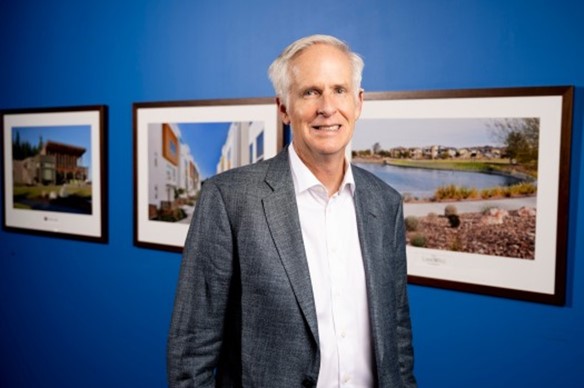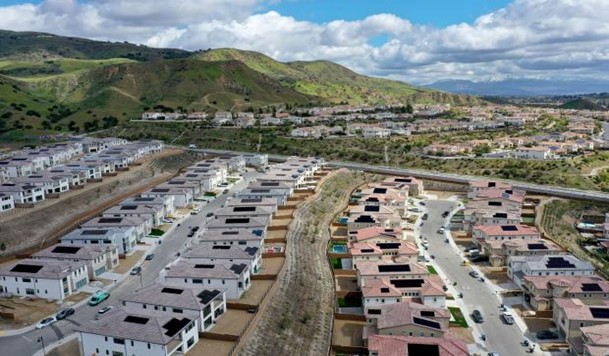Most of those calculations have very little analysis behind them, says John Burns.

John Burns of John Burns Research and Consulting in Irvine on Thursday, May 18, 2023. (Photo by Leonard Ortiz, Orange County Register/SCNG)
By JONATHAN LANSNER | Southern California News Group Columnist
PUBLISHED: May 22, 2023 at 10:03 a.m. | UPDATED: May 22, 2023 at 11:02 a.m.
https://www.eastbaytimes.com/2023/05/22/is-the-housing-shortage-overblown-this-analyst-thinks-so/
John Burns’ real estate research shop has become one of the housing industry’s top analytical firms by taking a more holistic view of what drives homebuying.
For two-plus decades, his eponymous Orange County-based company has become a critical cog in homebuilding thinking because its research looks far beyond real estate basics to encompass broader economic and demographic changes – not to mention the fleeting desire of house hunters.
So the company has now shed “real estate” from its corporate monicker, morphing into John Burns Research and Consulting from John Burns Real Estate Consulting.
Let me give you a noteworthy example from the novel Burns thinking: The company’s analysis suggests the nation is only 1.7 million homes short of what’s needed – a fraction of other housing shortage estimates.
Why so small, especially considering how high prices have become?
“Truthfully, it’s because they haven’t done their research,” Burns says. “They use back-of-the-envelope calculations: We normally build X number of homes per decade and last decade we only built Y. So we must be short 5 million homes. But that’s misses that we overbuilt the prior decade and we’ve got much less population growth. Most of those calculations have very little analysis behind them.”
And the pandemic’s buying binge, he adds, “was driven by dropping interest rates.”
The thought process behind the firm’s new name, its research, and housing dynamics can be summed up in this interview with Burns that’s been edited for length and clarity.
John Burns of John Burns Research and Consulting says most housing analysts are using outdated formulas to calculate the housing shortage. His firm’s research suggests the nation is only 1.7 million homes short of what’s needed.

(Photo by Dean Musgrove, Los Angeles Daily News/SCNG)
Q. How is your analysis different?
A: It’s really kind of at the heart of the people I’m hiring – doing great research and consulting as opposed to, you know, real estate people. And we just decided this new name says better who we are. And also we’ve grown. We have a lot of building products clients now. We have a lot of hedge funds. Those clients are literally using us to have a stronger view of what’s really going on in housing and the economy. So I’m using this as a platform to expand into different industries. That’s our future.
Q: Is the builder-consulting business still any good?
A: We grew 82% in the last two years. But this was really a diversification and growth opportunity. This wasn’t real estate going away at all.
Q, So what’s different about today’s new home shopper vs. 10-15-20 years ago?
A: Affordability and ‘What am I willing to sacrifice?’ They’re willing to give up the living room, the dining room. They’re really willing to give up the kitchen table and eat at a nice counter. They don’t need a big office. It’s about smaller square footage. But getting light into the house is absolutely positively critical. So there’s a lot of really cool things going on with window placement. That may not sound interesting but the homes being built are so dense it’s hard to get light inside unless you do things right.
Q. Work from home is key?
A: That’s been the game-changer. Even if it’s just 10% or 20% of people can work from home two days a week, that means that they will now live in places where they would not if I had to do that five days a week.
Q. Why can’t we get many starter homes built?
A: It’s kind of a price thing. I guess you could call it builder greed. But it’s really if builders put a smaller home on some of these lots, they would need to pay less for the land. And land sellers are not going to sell it. So literally, it’s not financially feasible for builders to pay market value for land and put a starter home on it. So there’s no business model without subsidies – or you go to the really outlying areas where the land is much less expensive.
Q. It’s stunning how few homes, new or existing, are being bought today.
A: I actually thought it was going to go below this. I do a lot of public speaking in front of a lot of audiences, now that they’re having audiences again. To hammer the point home, I ask: ‘Who owns a home with a 3.5% or less mortgage rate?’ Two-thirds raise their hand. ‘Okay, keep your hand up. If you’re looking to move.’ Everybody puts their hand down. It’s just there’s nothing on the market.
Q. Who could afford to buy even their own home today?
A: I am speaking in front of a lot of executives and a lot of them could. But why would you? We survey a lot of resale agents. The last survey found 10% of clients were moving, buying another home, and keeping their old home to rent out because the spread between the rent and a mortgage payment was so huge.
Q. If you magically became a housing czar with all sorts of powers, what would you suggest to fix some of this?
A: I’m not a policy guy. But I would focus on one thing that is not discussed enough, which is getting people’s incomes up. And California should have more of a growth orientation, where they accept growth. Like in the middle of California along I-5 or Highway 99. You could attract employers there and build cities there and focus on focus on areas where you don’t have to fight the NIMBYs.
I did some work in Korea in the mid-1990s. They were building cities outside of Seoul. Cities went from zero to 500,000 people in less than a decade because they built the infrastructure to get out there and they built the homes. People had a job or they were able to commute back into Seoul.
On the affordable housing side, building something new and affordable makes no sense to me. Taking that money and helping people rent or buy an older home that needs to be fixed up makes far more sense.
Q. So what do you think will happen next?
A: Mortgage-payment-to-income ratios need to come back in line through a combination of falling home prices, falling mortgage rates, and rising incomes. And all three of those things are happening right now. They’re just happening pretty slowly. We think that could happen by the end of next year.
The bond market is signaling that mortgage rates should be in the low 5%. Wage growth continues to be north of 4%. So we’re thinking that’s going to continue. And then we think home prices are going to keep falling.
The homebuilders have already dropped prices, the equivalent of 12%. The resale market hasn’t done that. So the homebuilders are actually selling pretty well because there is much better value. They’re buying down the buyer’s mortgage rate close to 5% and found a sweet spot there.
Jonathan Lansner is the business columnist for the Southern California News Group. He can be reached at jlansner@scng.com

